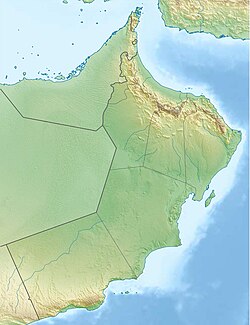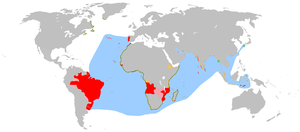Qalhat: Difference between revisions
m Reverted edits by Aditya.Harish 2003 (talk) to last version by 62.61.164.248 |
restoring to before vandalism |
||
| Line 1: | Line 1: | ||
{{Infobox UNESCO World Heritage Site |
{{Infobox UNESCO World Heritage Site |
||
Manger = Abubakkar Siddiq.M |
|||
| WHS = Ancient City of Qalhat |
| WHS = Ancient City of Qalhat |
||
| image = Bibi Maryam mausoleum.jpg |
| image = Bibi Maryam mausoleum.jpg |
||
Revision as of 18:40, 14 March 2019
| UNESCO World Heritage Site | |
|---|---|
 Bibi Maryam mausoleum | |
| Location | Sur Province, Ash Sharqiyah South Governorate, Oman |
| Criteria | Cultural: (ii), (iii) |
| Reference | 1537 |
| Inscription | 2018 (42nd Session) |
| Area | 75.82 ha |
| Buffer zone | 170.09 ha |
| Coordinates | 22°42′N 59°22′E / 22.700°N 59.367°E |
The ancient city of Qalhat, or Galhat (Template:Lang-ar) (in the map of Abraham Ortelius, it named as Calha), is located just over 20 km north of Sur, in the Ash Sharqiyah Region of northeastern Oman.
History and site description
Marco Polo visited Qalhat in the 13th century, referring to it as Calatu. Ibn Battuta visited the city in the 14th century,[1] noting that it had "fine bazaars and one of the most beautiful mosques." He further noted the mosque was built by Bibi Maryam and included walls of qashani. Bibi Maryam continued to rule Qalhat and Hurmuz after the death of her husband Ayaz in 1311 or 1312.[2] Zheng He visited the city in the 15th century, referring to it as 加剌哈 (Mandarin: jia-la-ha; Cantonese: gaa-laat-haa).[3]
Qalhat served as an important stop in the wider Indian Ocean trade network, and was also the second city of the Kingdom of Ormus. By 1507 when it was captured by Afonso de Albuquerque on behalf of the Portuguese Empire, the city were already in decline as trade shifted to Muscat.[1] Covering more than 60 acres (240,000 m2), Qalhat was surrounded by fortified walls that contained houses and shops. Very little remains of the ancient city, save for the now dome-less mausoleum of Bibi Maryam. Artifacts from as far away as Persia and China were found on-site.[1]
World Heritage Status
This site was added to the UNESCO World Heritage Tentative List on July 4, 1988 in the Cultural category.[1] The ancient city became a World Heritage site in 2018.[4]
Qalhat LNG Terminal
The Oman LNG LLC S.A.O.C. owned Qalhat LNG Terminal is situated at the Port of Qalhat.[5]
References
- ^ a b c d "The Ancient City of Galhat - UNESCO World Heritage Centre". UNESCO World Heritage Centre. Archived from the original on 1 February 2012. Retrieved 2 August 2018.
{{cite web}}: Cite has empty unknown parameter:|1=(help); Unknown parameter|deadurl=ignored (|url-status=suggested) (help) - ^ Battutah, Ibn (2002). The Travels of Ibn Battutah. London: Picador. pp. 96–98, 308. ISBN 9780330418799.
- ^ 向, 達 (1961). 鄭和航海圖. 北京: 中華書局.
- ^ "Ancient City of Qalhat". UNESCO.
- ^ Gas Media Releases Archived February 26, 2012, at the Wayback Machine

